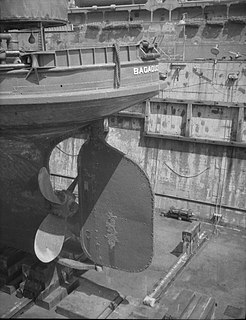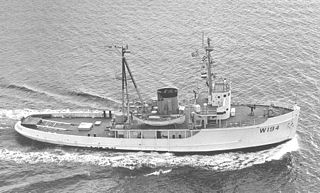
USS Accokeek (ATA-181) was an ATA-174 class auxiliary ocean tug in the service of the United States Navy, named after the Accokeek tribe of Native Americans.
USS Umpqua has been the name of three ships in the service of the United States Navy. The ship name comes from the Umpqua River in Oregon. The river in turn was named for the Umpqua tribe, a small tribe of Athabascan linguistic stock.
USS Keosanqua (ATA-198) was a Maricopa-class auxiliary fleet tug of the United States Navy. The ship was authorized as Rescue Ocean Tug ATR-125, and redesignated Auxiliary Fleet Tug USS ATA-198 on 15 May 1944. The ship was laid down at Levingston Shipbuilding Co., Orange, Texas, launched on 17 January 1945, and commissioned on 19 March 1945, Lieutenant J. L. Bean in command. She was named Keosanqua (ATA-198) on 16 July 1948.
USS Challenge (ATA-201) was a Sotoyomo-class auxiliary fleet tug acquired by the United States Navy for service during and after World War II.
USS Tunica (ATA-178) was a Sotoyomo-class auxiliary fleet tug acquired by the United States Navy for service during and after World War II.

USS Bagaduce (AT-21/ATO-21) was the lead ship of the Bagaduce class of fleet tugs for the United States Navy. She was the first ship of the U.S. Navy of that name, and is named for the Bagaduce River and a peninsula in Hancock County, Maine.
USS Penobscot (ATA-188/ATR–115) -- a Sotoyomo-class auxiliary fleet tug—was originally placed in service by the U.S. Navy as USS ATA–188 until she was renamed USS Penobscot (ATA-188) 16 July 1948. She served in the Pacific Ocean during World War II, and on the U.S. East Coast after the war’s end. She was finally decommissioned in 1971.
USS ATA-214 was the lead ship of the ATA-214 class of tugs for the United States Navy and was built near the end of World War II. Originally laid down as Palo Blanco (YN-85), a net tender of the Ailanthus class, she was redesignated as AN-64, a net layer, before launch. Before completion, the name Palo Blanco was cancelled and the ship was named ATA-214, an unnamed auxiliary ocean tug. Palo Blanco served in the Pacific Theatre during her brief career with the Navy..
USS ATA-216 was an ATA-214-class tug of the United States Navy built in 1944. Originally laid down as the net tender Allthorn of the Ailanthus class, she was redesignated before being launched. The ship was commissioned on 30 October 1944. ATA-216 had a brief naval career, and was decommissioned on 26 March 1946.

USS Yaupon (ATA-218) was an ATA-214-class tug of the United States Navy built near the end of World War II. Originally laid down as a net tender of the Ailanthus class, she was redesignated before being launched. The ship was commissioned on 10 March 1945. Yaupon had a brief naval career, and was decommissioned on 26 March 1946.
USS Sonoma (ATA-175) was a tugboat of the United States Navy, which served during World War II. She was the third Navy ship to bear the name "Sonoma", which is of American-Indian origin, in accordance with the Navy's naming convention for tugs.

USS Allegheny (ATA-179) was an American Sotoyomo-class auxiliary fleet tug launched in 1944 and serving until 1968. She underwent conversion to a research vessel in 1952.

The auxiliary ocean tug USS ATA-194 was laid down on 7 November 1944 at Orange, Texas, by the Levingston Ship Building Co.; launched 4 December 1944; and commissioned at Orange on 14 February 1945, Lieutenant William J. Bryan in command.
USS Bagaduce may refer to:

USS Mahopac (ATA-196) was a U.S. Navy Sotoyomo class auxiliary fleet tug laid down on 24 November 1944 and launched 21 December 1944. She served briefly in the Pacific Theater at the end of World War II, followed by extended assignments in Alaska and Japan. Between 1965 and 1969 she made periodic tours off the coast of Vietnam in support of 7th Fleet operations there during the Vietnam War.
The USS Pinola (AT–33) was a Bagaduce-class fleet tug, laid down on 3 March 1919 by Puget Sound Navy Yard in Bremerton, Washington, launched on the 12 August 1919, and was commissioned on 7 February 1920.

The Type V ship is a United States Maritime Commission (MARCOM) designation for World War II tugboats. Type V was used in World War II, Korean War and the Vietnam War. Type V ships were used to move ships and barges. Type V tugboats were made of either steel or wood hulls. There were four types of tugboats ordered for World War II. The largest type V design was the sea worthy 186-foot (57 m) long steel hull, V4-M-A1. The V4-M-A1 design was used by a number of manufacturers; a total of 49 were built. A smaller steel hull tugboat was the 94-foot (29 m) V2-ME-A1; 26 were built. The largest wooden hull was the 148-foot (45 m) V3-S-AH2, of which 14 were built. The smaller wooden hull was the 58-foot (18 m) V2-M-AL1, which 35 were built. Most V2-M-AL1 tugboats were sent to England for the war efforts under the lend-lease act. The Type V tugs served across the globe during Work War II including: Pacific War, European theatre and in the United States. SS Farallon and other Type V tugs were used to help built Normandy ports, including Mulberry harbour, on D-Day, June 6, 1944 and made nine round trips to Normandy to deliver Phoenix breakwaters.

The Bagaduce class was a class of United States Navy fleet tugs. The first ship of the class, USS Bagaduce (AT-21) was laid down on 16 July 1918 at Buffalo, New York, by the Ferguson Steel and Iron Company. She was briefly named Ammonoosuc in February 1919, renamed Bagaduce on 24 February 1919, launched 5 April 1919, and commissioned at Buffalo on 18 September 1919. The Bagaduce was constructed as part of the World War I shipbuilding program, and was the first of 19 new steel tugs designed to serve as minesweepers and conduct heavy-duty towing work at navy yards.








